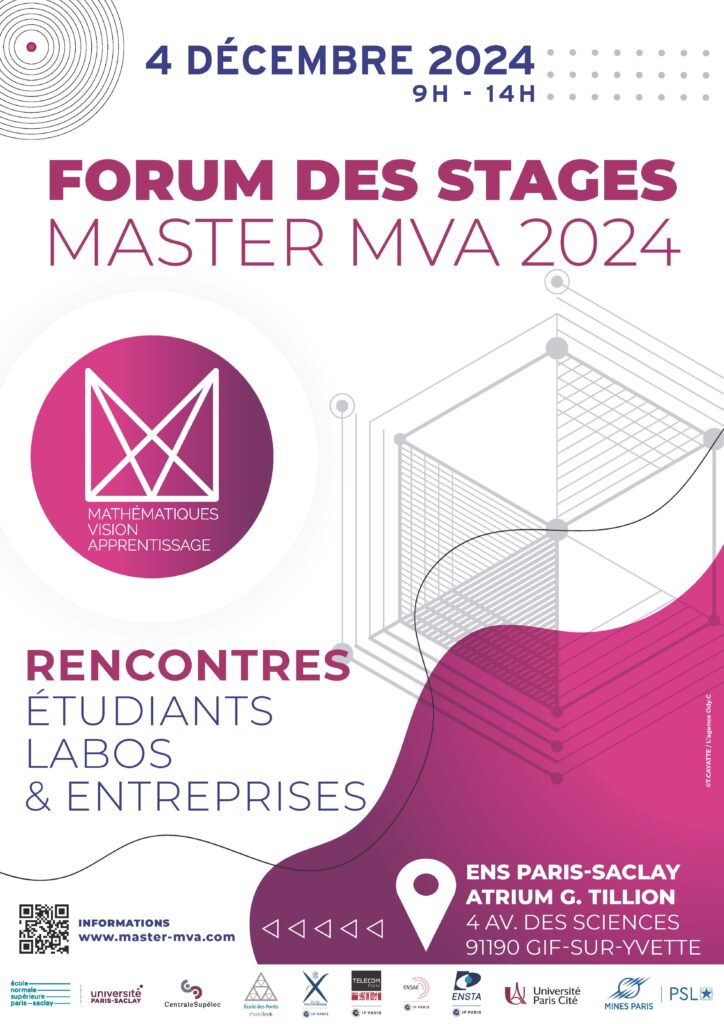Objectif du cours
This course will introduce students to advanced topics in modern geometric data analysis (the field known as Geometry Processing) with focus on:
- mathematical foundations (discrete differential geometry, mapping, optimization), and
- deep learning for best performing
We will give an overview of the foundations in surface-based analysis and processing before moving to modern techniques based on deep learning for solving problems such as 3D shape classification, correspondence, parametrization, etc. Finally, we will cover recent approaches for generating geometry, from both the mesh and shape-based perspectives.
Pour en savoir plus : Cliquez ici
Organisation des séances
— Lecture 1: Intro to Discrete Differential Geometry. Basic differential operators on surfaces in both the smooth and discrete settings. Operator discretization through FEM. Geodesics. Functions, derivatives, integration, convolution on surfaces.
TP topic[s]: Diffusion, Geodesics in Heat
— Lecture 2: Discrete Differential Geometry part 2. Spectral methods + manipulating geometry, Curvature. Shape deformation, Optimization of geometric energies. Surface parameterization. Mappings between surfaces. Basic surface topology, and topological constraints.
TP topic[s]: Toric covers CNNs on surfaces
Shape comparison, and basic shape matching. Spectral Signatures, HKS, WKS, GPS, etc.
— Lecture 3: Deep learning on curved surfaces. Intrinsic representations.
Surface-based learning. Parallel transport. Vector fields, Convolution on surfaces and triangle meshes. Geodesic CNNs and their variants. Feature propagation through parallel transport. Invariant vs. equivariant features
TP topic[s]: CNNs on Surfaces using Rotation-Equivariant Features
– Lecture 4: Global and local coordinate systems. Other surface-based learning methods. PointNet (for context), MeshCNN, DiffusionNet, DeltaConv, SpiralNet++.
Different applications + training of neural networks (segmentation, correspondence, classification). Graph-based learning.
TP topic[s]: DiffusionNet
— Lecture 5: Neural fields for surface representation, generation and analysis. Neural Radiance fields and Neural Fields regularization. DeepSDF, Occupancy networks, Fast Fourier Features.
TP topic[s]: SIREN, Implicit Displacement Field
— Lecture 6: Generative Modeling (how to generate the surface structure). Local synthesis. E.g., geometric texture synthesis. In-painting. Mesh generation, Differentiable meshing.
TP topic[s]: Point2Mesh.
Course supports will be in English (the course may be given in English if there is a non-French speaker in the class).
Mode de validation
Evaluation:
- Practical sessions (TPs)
- Mini quizzes (15 minutes every 2 lectures)
- Final projects (implement a paper from a list that we propose)
Thèmes abordés
1. First, we propose to cover the mathematical foundations of mesh-based 3D shape analysis (given by techniques from Discrete Differential Geometry and Geometry Processing more broadly), which form the foundation of many modern shape analysis and deep learning techniques, and which are not covered in any existing courses.
2. Secondly, we focus on Deep Learning on shapes represented as triangle meshes, which allows us to introduce intrinsic Geometric Deep Learning approaches.
3. Finally, we cover generative 3D modeling methods, based on Deep Learning solutions, including neural fields and differentiable meshing approaches, not covered in other courses of the MVA. The practical works will cover applications such as mesh deformation, isometric shape matching and intrinsic learning on surfaces in 3D, among others, which are not covered in other courses.
In addition to the points mentioned above, we outline the differences to three closest related courses.
4. Compared to the course “Nuages de points et modélisation ” However, in that course, the main focus is on capturing, representing and rendering point clouds, with a small amount learning on point cloud data. In contrast, our course focuses on 3D shape analysis (rather than reconstruction) and places a very significant emphasis on deep learning on 3D shapes across different representations (not only point clouds). Thus, our course is completely complementary to that course, and jointly we would cover both how 3D point clouds are acquired but also how 3D shapes (in different representations) can be analyzed and learned upon.
5. Compared to the “Geometric Data Analysis” (by Jean Feydy) course:
a. In that course there is very little deep learning. Seemingly only lecture 7 has some deep learning In contrast, our course contains a significant portion dedicated to deep learning, with focus especially on methods capable of learning on surfaces (triangle meshes), 3D point clouds and neural fields.
b. In that course, there is no content at all on triangle As a result, there is no discussion of Discrete Differential Geometry, which forms the theoretical foundation of many of the techniques that we focus on in our course.
c. In that course, there is no content nor any lab sessions dedicated to problems in 3D shape understanding or shape analysis: 3D shape classification, shape segmentation, shape parametrization, correspondence, etc. This is the main focus of our course.
d. In that course, there is no discussion of spectral methods, which form a significant part of our course (feature extraction, non-rigid shape correspondence, etc.)
e. We also introduce Implicit Neural Representations which are a modern way for representing geometric surfaces that enables a lot of applications.
f. Overall, we would say that our course is completely complementary to that course. For example, we provide both the foundation and an extended treatment for « Convolutions on 3D objects » and the topics that are only very briefly mentioned in Lecture 7 of Jean Feydy’s course.
6. There is little relation to Topological Data Analysis course. That course mostly focuses on (persistent) homology and related tools for data analysis. In our course, topology is only addressed insofar as it places constraints on shape understanding — g., in shape parametrization.
We also mention that our course will be a natural complement to the course “Deep Learning” by V.LEPETIT, M. VAKALOPOULOU. This is because our course will introduce techniques for both learning on non-Euclidean domains, and generating geometric data with deep learning methods.
Etienne CORMAN
(CNRS, LORIA)
Julie DIGNE
(CNRS, LIRIS)
Maks OVSJANIKOV
(École Polytechnique, LIX)
